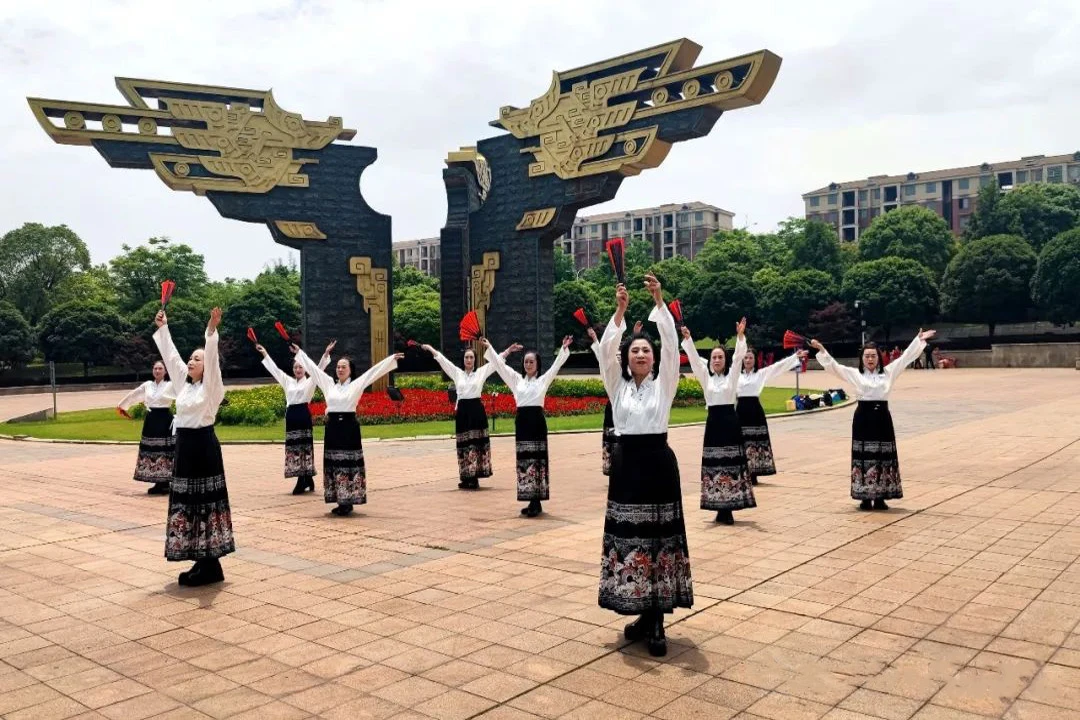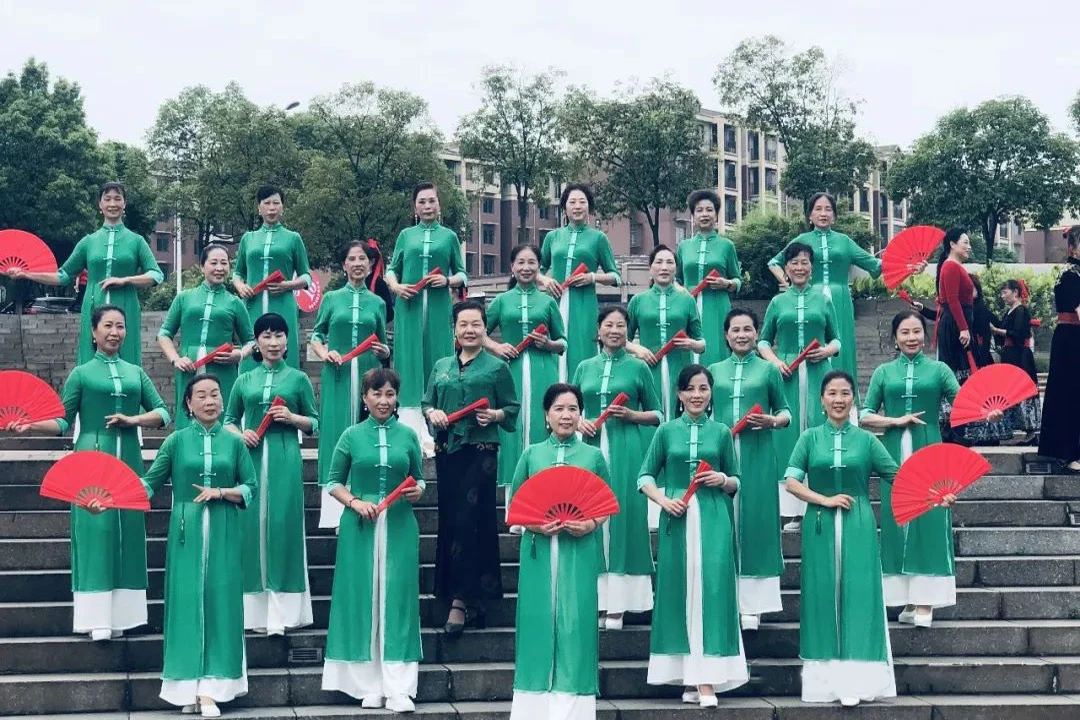On the morning of May 16, under the clear skies and gentle breeze at the square outside Nanhu Park, the Hengyang Qipao Cultural Association held a spectacular flash mob event as part of the 2024 “Hengzhou Fashion Week” intangible cultural heritage (ICH) and national trend showcase. With the theme “Qipao’s Elegance Gathers Beauties in Yancheng,” the event aimed to showcase ICH costumes and national trend culture, fostering a greater appreciation and understanding of Chinese qipao and ICH cultural heritage among the public.
At 9 a.m., the event officially commenced, and performers from 14 art troupes, dressed in various styles of qipao and traditional attire, treated the audience to a visual feast. These costumes not only showcased the unique charm of qipao but also incorporated elements of ICH costume culture, such as mamian skirts, hanfu, and ethnic clothing, allowing people to appreciate the beauty while experiencing the profound cultural heritage of ICH.
The event venue was filled with melodious music and orderly performances. The qipao fashion show and the Fashion TV team presented a flash mob display, with graceful team members dressed in exquisite and glamorous qipao, hanfu, and mamian skirts. The embroidery and patterns on the costumes shimmered under the sunlight, and their elegant and healthy demeanor, combined with light and firm steps, earned thunderous applause from the audience.
As the music rhythm progressed, dance art troupes took the stage one after another. Their fluid and rhythmic movements were full of artistic tension and beauty, immersing the audience in a dreamlike artistic world. The performances were filled with vitality and passion, allowing everyone to be engrossed in the ocean of dance and feel the charm and power of art.
Among the flash mob performance teams, Blueberry Hand Drum Team, Nanyan Art Troupe, Caixia Performance Team, Mulin Sunshine Team, Yunzi’s four art troupes, Yan Zhiyun Team, Good Fortune Team, Splendid Style Team, Xingya Model Team, Zhengxiang Century City Team, and the President’s Observation Team of the City Qipao Association showcased their unique characteristics, and their wonderful performances won rounds of applause from the audience.
The successful organization of this event not only added a bright touch to the cultural construction of Hengyang City but also played a positive role in promoting the inheritance and development of qipao culture and ICH culture. It is believed that with the joint efforts of all sectors of society, qipao culture and ICH culture will shine even more brilliantly in the new era.
Liu Fang, president of the Hengyang Qipao Cultural Association, stated that qipao culture and ICH culture are precious treasures of the Chinese nation, and it is our responsibility and obligation to inherit and carry them forward. In the future, the association will continue to hold various forms of activities to allow more people to understand and appreciate qipao culture and ICH culture, making positive contributions to the development of cultural undertakings.
The “Hengzhou Fashion Week” flash mob event not only provided a platform for the display of traditional Chinese clothing and intangible cultural heritage but also served as a reminder of the importance of preserving and promoting these cultural treasures. The event’s success demonstrates the growing interest and appreciation for traditional Chinese culture among the public, particularly the younger generation.
The qipao, a form-fitting dress that originated in Shanghai in the 1920s, has become an iconic symbol of Chinese fashion and femininity. Its unique blend of traditional Chinese elements and Western-influenced tailoring has made it a timeless classic that continues to captivate fashion enthusiasts around the world. The inclusion of qipao in the flash mob event highlights its enduring appeal and cultural significance.
Similarly, the incorporation of other traditional Chinese clothing styles, such as hanfu and mamian skirts, showcases the rich diversity of China’s sartorial heritage. Hanfu, the traditional clothing of the Han Chinese, has experienced a resurgence in popularity in recent years, with many young people embracing it as a way to connect with their cultural roots. Mamian skirts, a type of pleated skirt worn by women in various regions of China, are known for their elegant draping and intricate embroidery.
The flash mob event also highlighted the importance of preserving and promoting intangible cultural heritage (ICH). ICH refers to the practices, representations, expressions, knowledge, and skills that communities recognize as part of their cultural heritage. This includes oral traditions, performing arts, social practices, rituals, festive events, and traditional craftsmanship.
In recent years, there has been a growing recognition of the need to safeguard ICH, as many traditional practices and skills are at risk of being lost due to rapid modernization and globalization. Events like the “Hengzhou Fashion Week” flash mob play a crucial role in raising awareness about the value of ICH and encouraging its transmission to younger generations.
The event’s success is a testament to the hard work and dedication of the Hengyang Qipao Cultural Association and the participating art troupes. By bringing together performers from diverse backgrounds and showcasing a wide range of traditional clothing styles, the event fostered a sense of unity and pride in China’s cultural heritage.
Moreover, the event’s positive reception by the public demonstrates the growing appetite for cultural experiences that celebrate tradition and innovation. As Liu Fang, president of the Hengyang Qipao Cultural Association, noted, there is a responsibility and obligation to ensure that qipao culture and ICH are passed down to future generations.
To achieve this goal, it is essential to engage young people and make traditional culture relevant and accessible to them. Events like the flash mob, which combine elements of fashion, music, and dance, are an effective way to capture the attention of younger audiences and spark their interest in cultural heritage.
In addition to public events, there is a need for educational initiatives that promote the study and appreciation of traditional Chinese clothing and ICH. This could include workshops, exhibitions, and curriculum development in schools and universities. By providing opportunities for young people to learn about and engage with their cultural heritage, we can ensure that these traditions remain vibrant and relevant in the modern era.
Furthermore, the preservation and promotion of qipao culture and ICH require the support and collaboration of various stakeholders, including government agencies, cultural institutions, and the private sector. By working together to create an enabling environment for the transmission and development of traditional culture, we can ensure that these treasures are not lost to the sands of time.
In conclusion, the “Hengzhou Fashion Week” flash mob event organized by the Hengyang Qipao Cultural Association was a resounding success, showcasing the beauty and diversity of traditional Chinese clothing and intangible cultural heritage. The event’s positive reception by the public demonstrates the growing interest and appreciation for cultural experiences that celebrate tradition and innovation.



